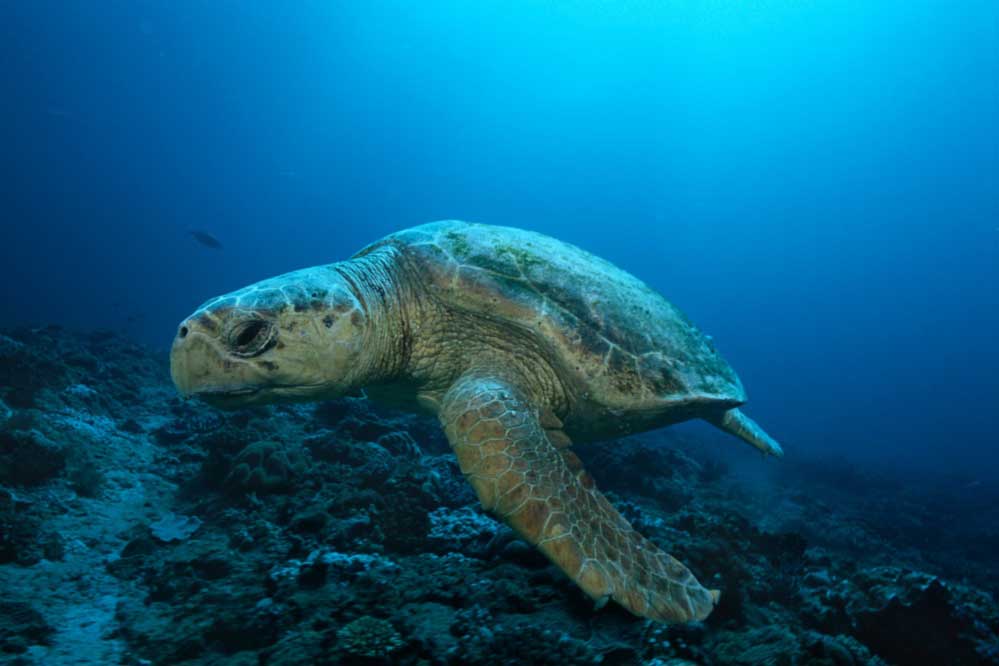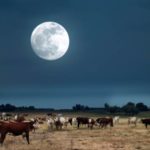The moon and stars lighted the sand as our four-wheeler crossed and re-crossed the beach. We’d been searching for loggerhead turtle tracks for a couple hours but had yet to be rewarded.
Lynn and I’d stopped at the information center earlier that day after crossing from the South Carolina mainland onto Hilton Head Island. We always stopped there rather than going straight to our condo because they frequently told us about adventures that were available on the island. Today, they recommended a nighttime sea turtle experience. The Hilton Head turtle patrol was taking visitors onto the beach after dark to try and locate female turtles that had come ashore to lay eggs.
The loggerhead sea turtle is South Carolina’s state reptile. It is so named because of its extra-large head. The loggerhead is on the federal and state’s threatened species lists, so every precaution is taken to help them propagate. The loggerhead is a large ocean turtle, reaching a top-shell width of 30 to 42 inches and a weight of up to 400 pounds, with a lifespan of about 100 years. Because it’s so large and protected by its shell, it has few natural enemies in adulthood, but it faces many enemies while still a hatchling.
Its first danger occurs after it digs its way upward through its sand nest, and then makes a mad dash to the ocean. The moon and starlight reflecting off the water become its beacon, drawing it toward the water’s safety. But if there are lights behind it, they can attract it to a certain death far away from the water.
Even when the hatchlings head in the right direction, they must run a gauntlet of birds, crabs, raccoons, and other predators searching for an easy meal. If they reach the safety of the ocean, they’ll find that it’s not so safe after all. A horde of seabirds and fish wait there, hoping to snatch their meal. It’s estimated that somewhere between one in 1,000 to one in 10,000 hatchlings survive into adulthood.
The mother loggerheads face danger, too. South Carolina reports boat strikes as the leading source of loggerhead deaths. But she may also be strangled by plastic bags, balloons, or other beach litter that she mistakes for food.
The female loggerhead comes ashore at nighttime between early May and late August to lay her eggs on Hilton Head’s beaches. She judges the sand’s moisture and temperature to decide where to lay those eggs. She digs her nest with her rear flippers, deep enough to hold about 120 eggs. She then covers the hole, rearranges the sand with her front flippers, and compresses the sand with her body weight. The eggs incubate for about two months before hatching. The hatchling’s sex is determined by the sand’s temperature. Warmer temperatures produce females; cooler temperatures produce males.
Hilton Head Island has developed ordinances to protect these turtles. All lights that can be seen from the beaches must be extinguished or shuttered between 10 p.m. and 6 a.m. from May through October. Beach tents and litter must be removed, and holes that the hatchlings might fall into must be filled. Teams, directed by the Department of Natural Resources, patrol the beaches and enforce the ordinances. They also locate, mark, and report nests so that they can be closely monitored and protected.
It was one of these beach patrols that took us searching for female turtles that night. We’d already been out for two hours but hadn’t seen any evidence of female turtle tracks on the sand. Our leader said, “We’ll swing down the beach one more time, but we’ll then call it quits if we don’t see any.”
He drove slowly down the beach, the three of us looking carefully for any indication of a turtle having crawled up the sand beach. We’d almost returned to our exit point when we saw it. Tracks, heading toward the top of the beach. Our guide told us to remain in the four-wheeler while he investigated further, saying, “We can’t disturb the lady until she’s well into laying her eggs. Then, she goes into a malaise where she seems to ignore outside disturbances. I’ll return when I think it’s safe for you to come forward.”
Excited to have this magical experience, we waited for what seemed to be an eternity for his return. But he returned and beckoned us forward. We approached the top of the beach slowly, not wanting to disturb this sacred process that had blessed the ocean’s beaches for centuries.
And it was a magical moment. Mother Loggerhead was intent on her mission, squatting over her nest with an egg dropping into the void every few moments.
She was so intent on her work that she didn’t seem to notice us as we kneeled far enough away that we could see, but not so close as to disturb her. We didn’t stay to see the last eggs drop or the closing of the hole, but we were their long enough to know that we’d seen a repeat of nature’s life-giving miracle, one that had occurred for the ultra-millionth time.
I slept restlessly that night, dreaming of those little hatchlings being pursued by all kinds of nasty predators. Every now and then, an old poem, “The Walrus and the Carpenter,” interrupted my slumber with visions of the title characters—and litter all around.
“The time has come,” the Walrus said,
“To talk of many things:
Of shoes—and ships—of sealing wax—
Of cabbages—and kings—
And why the sea is boiling hot—
And whether pigs have wings.”
“O Oysters,” said the Carpenter,
“You’ve had a pleasant run!
Shall we be trotting home again?”
But answer came there none—
And this was scarcely odd, because
They’d eaten every one.”
I tried my hardest to visualize oysters—but all I could see were pieces of little loggerhead hatchlings littering the sands.









